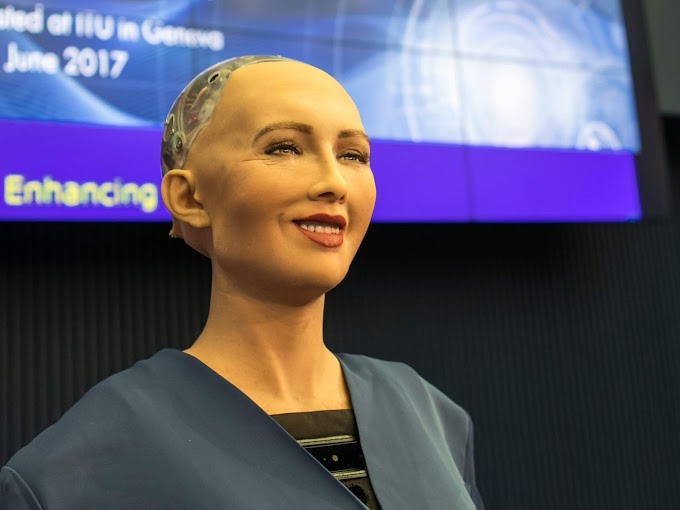The
making of Sophia is described and commented, a new humanoid robot that stands
out for having been built with the latest advances in Artificial Intelligence
(AI) that allow it, for example, to learn and gain experience from its
interaction with human beings. Also, its appearance and wide repertoire of
facial gestures that it has, significantly brings
it closer
to the human pattern. Its presence has gained notoriety for her presentations
in at least a couple of United Nations events and
also for having received Saudi citizenship, being the first robot in the world
to hold that status.
Sophia’s
particular technological qualities have begun to generate
repercussions of various kinds, not only in the academic-scientific world, but also ethically, artistically, religiously,
morally, politically and economically. From the above, it can be affirmed
that Sophia has
marked the beginning of a new era, not only robotic but also technological in
general, which now allows to see with greater certainty the real emergence of a
successor of the human species The great advances that are currently
being achieved in the field of Artificial Intelligence (AI), are really
surprising. The fact that a machine
manages to learn from experience, accumulates knowledge, and finally makes
intelligent decisions according to the circumstances, already speaks of a
rudimentary consciousness, or at least of an incipient ability to make
judgments and act accordingly.
This,
which may sound scandalous to some academics, is already analyzed by
researchers who propose a new Epistemology, equipped with a broader Theory of
Knowledge, by which the conscience is not conceived as privative of the human
being, but -and with greater reason still- as an essential part of our
successors: the humanoid robots.
Sophia
is a humanoid robot. And although it does not exhibit at the moment the most spectacular
qualities that are expected of the AI; with her linguistic performance, her
communicative skills, and her emotive externalizations, she has already
achieved in her short time of life, being accredited as the First World Citizen
Robot (by Saudi Arabia). It is a robot that is in continuous improvement, which
learns by the socialization to which it is subjected in each interview it has,
and that has just marked the end of a technological era and the beginning of
another, leaving behind the classic robots that we have all known: metallic machines with noisy gears, clumsy movements,
and border intelligence. Today we are witnessing
a new robotic generation, with fine anthropomorphic features, fluid linguistic
communication, and even the ability to joke with the interviewer, thanks to an
intelligence never before perceived in anyone other than a human being
WHO OR WHAT IS SOPHIA?
Sophia is a robot with the image of a
middle-aged woman, who is actually only two and a half years old. It is a
humanoid machine developed in Hong Kong by the American company Hanson
Robotics, and activated from April 19, 2015. Sophia's main technological quality
is her ability to learn human behaviors through her interaction with people.
For this, it has been endowed with the most recent advances in the field of AI,
such as the mastery of a complex series of predictive algorithms based on
computational statistics; a fluid synthetic vocalization, a rapid processing of
the information that she receives, and a broad ability to recognize faces and
voices. The British actress Audrey Hepburn has served as a model to design the
face of Sophia, who still lacks lower extremities, which are in the process of
being built. It is also remarkable her ability to talk about specific issues
and to show at the same time many facial expressions and human gestures.
Because
of her amazing human qualities, the Saudi government has granted Sophia the
citizenship of her country during the Summit on Investment in the
Future held in Riyadh on October 25 of this year (2017). It is undoubtedly an
unprecedented event in the history of humanity. At the head of the team of
creators of Sophia, is David Hanson, an American mechatronic engineer, PhD in
Aesthetic Studies, Interactive Art and Engineering, by the University of Texas
(2007). Hanson became known worldwide for a first humanoid robot (2005) whose
face resembled that of the famous scientist Albert Einstein. In that same year,
Hanson and his team received an award from the American Association for the Advancement
of Science “in merit to the construction of an intelligent conversational
portrait of Philip Dick”, a renowned post-modernist science fiction writer.
(Wikipedia, 2017).
AN OLD SEARCH
Nils Nilsson in his work The Quest for
Artificial Intelligence, mentions that since the times of Homer it was spoken
-for example in The Iliad- about "self-powered chairs called tripods, and
golden assistants built by Hephaistos, the god lame blacksmith, who helped him
to walk" (Nilsson, 2010, p.3). Similarly, following the ancient tales of the
Roman Poet Publics Oviduct summarized in his Metamorphoses; the famous sculptor
Pygmalion elaborated the image of a beautiful maiden whom he called Galatea,
who finally came to life by the goddess Venus.
The poet relates that she
"was able to feel the kisses that her sculptor gave her, and she blushed,
raising her shy eyes towards the light, looking at her lover and the sky"
(Nilsson, Op. Cit.). Advancing rapidly in time, only 61 years ago, a historic
meeting of scientists - mainly mathematicians and logicians took place in New
Hampshire (United States) in order to see to what extent it was really possible
to make all those huge and slow computers of that time, be able to perform intelligent
actions, imitating human behavior. For this, more than concentrating on the machine
and its electronic components, they pinned their hopes on the programs (ordered
information or software) that made them work. It had already been tried before
by researchers such as Allan Turing, Norbert Wiener, John von Neumann, and
Warren Mc Tulloch.
But they did not have a computer. The new entrepreneurs
already had this device, and hence their well-founded optimism. Celebrities
present at that meeting were among others, John Mac Cathy, Marvin Minsky,
Herbert Simon, and Allen Newell. (Gardner, 1985. The New Science of the Mind). Gardner
mentions that during that time there was also another meeting of researchers at
the Massachusetts Institute of Technology, who in their own way also contributed
to the birth of Artificial Intelligence. There they were, for example, Noam Chomsky
(specialist in Linguistics), and George Miller (specialist in Psychology). All together
gave rise to a new cognitive science, which reinforced with publications such as
those made by Jean Piaget, Bruner, Levy-Strauss, Minsky, and Chomsky, end up contributing
to the birth of Artificial Intelligence, understood as “that branch of computing
that is dedicated to programming computers so that they perform tasks that, if
they were done by a human being, would be classified as intelligent tasks"
(Minsky, Semantic Information Processing). Subsequently, Newell, Shaw, and Simon
demonstrate that AI is perfectly feasible to be achieved and perfected for
three reasons:
1)
Computers are already capable of performing small actions that are
widely recognized as intelligent by human beings themselves.
2) The programs (software) made for
computers follow exactly the same steps that a human being does when he
reasons.
3) A computer has short and long term
memory (ROM and RAM), has an operating system, a control center, and various elements
of both reception and emission (peripheral in - out) as well as a human brain.
Howard Gardner (1985) in chapter IV of
his book The New Science of the Mind (Opacity.) concludes that everything
achieved and demonstrated by the AI up to that date, had ended by unleashing
deep and unexpected philosophical questions that should not be overlooked.
However, to do so, he proposed to stick "only to what in the moment exists
and works efficiently in the field of AI, and not so much to its
possibilities". He also mentions that researchers like Marshall and
Longuet-Higgings had identified very close links between Experimental Psychology
and AI. And that both fields of knowledge could be united to form a new
cognitive science, but always accompanied by Philosophy as a source of
permanent questioning; and Linguistics, as a vital factor of human cognition.
From Gardner's prudent comments - made
in the last century - to the present, even unexpected achievements have been
made by the scientists themselves in the field of AI. The emergence of the
Internet was a huge advance. Likewise, the discoveries made by Quantum Physics,
the miniaturization of multiple functions housed in a single device
(smartphone), and the enormous steps taken by Nanotechnology, have ended up producing
an AI that for many more resembles acts of magic. Nowadays, the prototype of
all these achievements, is without a doubt, Sophia.
DESCRIBING SOPHIA
Sophia is a robot with an attractive
female face, built so far only to its waist. Her eyes are cameras with the
ability to recognize faces she has seen before (which allows her say hello to
anyone by name). Her skin is made of a special variety of silicone (Flubbed),
which is flexible enough to perform 62 facial expressions (anger, joy, sadness,
amazement, annoyance, fear, etc.). She has an electronic synthetic voice system
that allows her to speak and gesticulate as she makes her speech. However, the
most "human" aspect of this robot is its ability to learn from the
experience it gains whenever it has the chance to interact with people.
Thus, Sophia becomes increasingly familiar
with the culture, customs, feelings, emotions, and linguistic styles of her
interlocutors. And all this experience is accumulating in her memory. When asked
to give a precise answer on a topic, she googles (looks for it in Wikipedia,
etc.) just like today's kids do in their homes or in their classrooms. However,
Sophia is still slow to respond, and she makes many mistakes, because despite
her appearance as an adult woman, she still has a short learning time. One of
the goals of its creators, with David Hanson at the head, is that Sophia manages
not only to maintain an intelligent conversation with human beings on any topic,
and on her own initiative, but that her dialogues are always accompanied by the
emotional charge that characterizes the normal conversation between two people.
(El Comerica, digital version, October 27, 2017). At the moment, Sophia's main
activity is to hold "live" interviews with various journalists from
well-known global news networks. At the end of the interviews, almost all these
experienced journalists have declared to have lived a unique emotional
experience in what concerns the exercise of them profession.










0 Comments